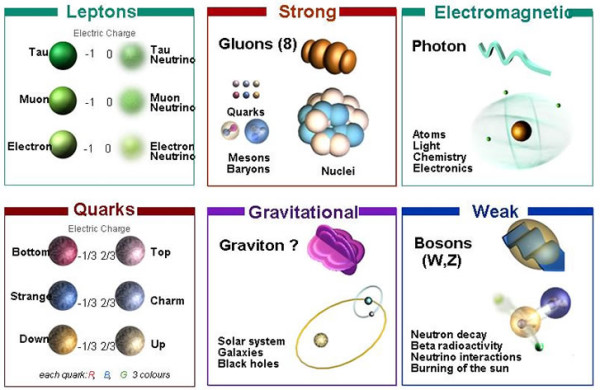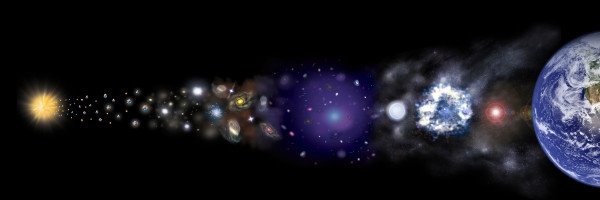“The joy of life consists in the exercise of one’s energies, continual growth, constant change, the enjoyment of every new experience. To stop means simply to die. The eternal mistake of mankind is to set up an attainable ideal.” -Aleister Crowley
Our Universe is the way it is for two reasons: the initial conditions that it started off with, and the fundamental particles, interactions and laws that govern it.
When it comes to the physical properties of everything that exists, we can ask ourselves how many fundamental, dimensionless constants or parameters it takes to give us a complete description of everything we observe.
 Image credit: Ananth of http://countinfinity.blogspot.com/.
Image credit: Ananth of http://countinfinity.blogspot.com/.
Surprisingly, the answer is 26 (not 42), and there are a few things that remain unexplained even with all of them. Go read the full story.


@Ethan: I'm a little uncomfortable with one of your assertions at the start of your article. You write, regarding either simulations or hypothetical "rewinding history" (in Stephen Jay Gould's words),
"By time the Universe is as old as ours is — 13.8 billion years — it will look exactly the same every time in so many important ways:
[...]
perhaps most importantly, all of the fundamental constants will have the same value."
But if you're talking about simualtions like Millenium or VIa Lactea, the fundamental constants are put in by hand, so they can't change. I'm not familiar with a large scale cosmological simulation which has tried to deal with time-varying constants.
It seems to me that we really _don't_ know how likely our particular set of constants is. Since you're the astrophysicist, if I'm wrong, could you point me toward a decent review?
The new plank report adds 140 million years until the first stars formed, is this a big deal?
@ Michael K
I have to agree with you remark, because I asked the very same question back in 2013 when Ethan first wrote this article. :)
http://scienceblogs.com/startswithabang/2013/05/29/the-fundamental-cons…
But I was assured by other commenters that it's just my misunderstanding of the spirit in which the sentence is written. Now that some time has passed, the only way I can see of not having the same problem with that sentence is that perhaps it's very much possible that given initial conditions and constants, the system can evolve in such a way that those constants are not of same value after certain time (being constant in space, but not time). Then the fact that they don't change in the simulation is fascinating.
But this of course depends on the actual algorithms, which I know nothing about. If the simulation is setup in such a way that constants don't change in time i.e. the same initial values for constants are taken for every calculation cycle... then there is nothing special in that they have same values. And I share your sentiment that something is off about that sentence.
It still is.
Euclidian (and to the limit of applicability Mnkowski spacetimes) geometry INEVITABLY lead to the ratio of a circumference of a circle to its diameter is 3.14..... and so on, ALWAYS.
It doesn't matter how you get an Euclidian space, pi is still the same value.
It can be filled with tables or with croquet lawns, but pi is still pi on those euclidian surfaces.
Consider the triple-alpha resonance. If it were in a different place then stars would not be able to produce Carbon in their interiors. Except their interiors have a temperature set by the need to create more fusion events. So if the resonance was different, the star would change its temperature and fit the same amazing coincidence. And stars would still look the same. Hot burny thing turning hydrogen into helium and thence into carbon.
@ Wow
it might be that the whole confusion is we think of different constants in that particular sentence. Because I understood is as:
1. you input fundamental constants in the begining of simulation i.e. magnetic flux = 2.067
2. then you run the simulation to i.e. 10bl. years
3. see what you get.. i.e. galaxies, clusters etc..
4. and you look at magnetic flux constant at 10bl years and you see it's still 2.067.. and this is somehow a great confirmation of something? why? why would you even expect that same constant to somehow change?
BUT
if you input that same magnetic flux, and then after the run, you i.e. look at Pi or SOME OTHER constant that you DIDN'T input at the beginning, and it matches real world, then yes.. that is an amazing confirmation of theory and model. So I guess it was written in that spirit.
Aye, SL, that's the way I see it.
E.g. electric charge of quarks don't become 0.233347e because we changed the electric charge. A silly, silly example, admitted :-)
English has so much redundancy it's easy to get the wrong end of the stick without any intent of finding the wrong end. It's an embuggerance.
I'm hoping for something better than anthropics and the concept of Meta Laws for which we will probably never know why the fundamental constants take the values they do. Paul Davies calls these Meta Laws being analogous to a 'transcendent god". If Science has reached this kind of end (which I don't believe in) what is to keep it from descending into a dangerous sort of mysticism '(things just are what they are' or 'it is what it is' and here is some random math which you will not understand but it requires knowledge which shows that we don't understand it either)? Then perhaps the ancient surreal babblings of Mayan priests served their masters well. They could even do precision mathmatical astronomical observations/predictions which served the State well.
No god you or any other religion espouse, Mark. A deist god, only.
Therefore a statement of no value or purpose other than to muddy waters. Don't make it.
Perhaps the ancient surreal babblings of religion (Mayan included: why is Marduk not god, therefore everyone alive today destined to hell?) are just surreal babblings.
Because religions such as theirs do not demand you question and test their precepts and conclusions against reality. Science does. Keep that idea in mind before bewailing mystecism in science.
42, interesting...I've had a 420 phenomenon for over 10 years now..I see the number everywhere and in the strangest of places...and of course nothing to do with pot. Any insights...and love the Crowley Quote by way
oh and I can add to the convo..and shall in brief until I get questioned. Nothing changes. Change is can only happen in the Aether. History speaks for itself. 1+1 shall always equal 2. Universal, carnal laws are perceptually unbreakable. but non-perception is intangible..so there, ponder in that
I Call Hitchens, Brody: That which is asserted without evidence can be dismissed without evidence.
What maroons you aether buddies are.